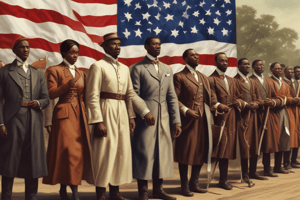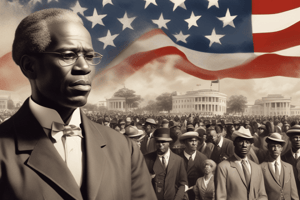Podcast
Questions and Answers
What was a major consequence of the return to power of pre-war southern leadership during Reconstruction?
What was a major consequence of the return to power of pre-war southern leadership during Reconstruction?
- Immediate granting of land to former slaves
- Restoration of the Confederacy's military forces
- Increased control by Republicans in Congress (correct)
- Complete dissolution of the Ku Klux Klan
What goal did the Fourteenth Amendment primarily aim to achieve?
What goal did the Fourteenth Amendment primarily aim to achieve?
- Ensure the right to vote for all men over 21
- Decentralize federal authority in favor of state governance
- Establish citizenship and equal protection under the law for all persons (correct)
- Guarantee the right to bear arms for Southern citizens
What was one of the significant challenges African Americans faced after Reconstruction?
What was one of the significant challenges African Americans faced after Reconstruction?
- Implementation of segregation and discriminatory laws (correct)
- Full integration into northern schools and communities
- Establishment of laws favoring immediate land ownership
- Complete control of local governments
Which group was known for opposing Reconstruction efforts through violence and intimidation?
Which group was known for opposing Reconstruction efforts through violence and intimidation?
What role did Congress take in Reconstruction after opposition to President Johnson's plan?
What role did Congress take in Reconstruction after opposition to President Johnson's plan?
Which aspect of President Johnson's Reconstruction Plan was most criticized by Congress?
Which aspect of President Johnson's Reconstruction Plan was most criticized by Congress?
What was a key outcome of the Fourteenth Amendment that shifted the power dynamics in the South?
What was a key outcome of the Fourteenth Amendment that shifted the power dynamics in the South?
What tactic did the Ku Klux Klan primarily use to assert their influence during Reconstruction?
What tactic did the Ku Klux Klan primarily use to assert their influence during Reconstruction?
What shift occurred in the control of Reconstruction as President Johnson faced opposition?
What shift occurred in the control of Reconstruction as President Johnson faced opposition?
Which activity marked the end of Reconstruction in the South?
Which activity marked the end of Reconstruction in the South?
What type of governments were established during the Reconstruction in the South?
What type of governments were established during the Reconstruction in the South?
What role did African Americans primarily play in Southern industry during Reconstruction?
What role did African Americans primarily play in Southern industry during Reconstruction?
What significant resistance did Congress face in implementing Reconstruction policies?
What significant resistance did Congress face in implementing Reconstruction policies?
Flashcards are hidden until you start studying
Study Notes
Reconstruction Overview
- Reconstruction aimed to rebuild the Union post-Civil War, addressing political, social, and economic issues in the South.
- The process was marked by struggles over political power and civil rights for African Americans.
Rebuilding the South
- Reconstruction commenced with challenges such as infrastructure damage and economic instability.
- The transition from slavery to freedom for African Americans involved legal and social transformations.
Freedom for African Americans
- Emancipation led to significant changes in the status of African Americans, striving for equality and civil rights.
- Freedmen sought opportunities in education, employment, and land ownership, facing a hostile environment.
President Johnson's Reconstruction Plan
- Johnson's approach favored leniency and rapid reintegration of Southern states without stringent safeguards for African American rights.
- His policies drew criticism for allowing former Confederates to reclaim political power.
Fight Over Reconstruction
- The emergence of former Confederates in power prompted conflict with the Republican-led Congress, which sought stronger measures.
- Johnson faced significant opposition from Congress, leading to his impeachment but ultimately acquittal.
Fourteenth Amendment
- Ratified in 1868, it granted citizenship to all persons born or naturalized in the U.S. and guaranteed equal protection under the law.
- Aimed to protect the rights of African Americans and curb the influence of Southern Democrats.
Congress Takes Control of Reconstruction
- Congressional Reconstruction imposed stricter requirements for Southern states to rejoin the Union, including military oversight.
- Republicans enacted legislation ensuring civil rights and protections for African Americans amid Southern resistance.
Fifteenth Amendment
- Ratified in 1870, it prohibited denying voting rights based on race, color, or previous servitude.
- Symbolized a major advancement in civil rights, despite ongoing disenfranchisement tactics in the South.
Reconstruction in the South
- Reconstruction governments were established, often facing challenges from insurgent groups and economic hardships.
- The Ku Klux Klan emerged to intimidate and suppress African American political participation and social mobility.
Reconstruction Ends
- By the late 1870s, federal support for Reconstruction dwindled, leading to the withdrawal of troops and the end of military governance in the South.
- This marked the resurgence of white supremacist policies and institutions, undermining gains made during Reconstruction.
Rebuilding Southern Industry
- The South attempted to diversify its economy from agriculture to industry, though progress was limited by economic conditions and social resistance.
Reconstruction in the North
- Northern states witnessed their own struggles with integrating returning soldiers and addressing civil rights post-war.
- The broader implications of Reconstruction efforts influenced national politics and civil rights debates beyond the South.
Reconstruction Overview
- Reconstruction aimed to rebuild the Union post-Civil War, addressing political, social, and economic issues in the South.
- The process was marked by struggles over political power and civil rights for African Americans.
Rebuilding the South
- Reconstruction commenced with challenges such as infrastructure damage and economic instability.
- The transition from slavery to freedom for African Americans involved legal and social transformations.
Freedom for African Americans
- Emancipation led to significant changes in the status of African Americans, striving for equality and civil rights.
- Freedmen sought opportunities in education, employment, and land ownership, facing a hostile environment.
President Johnson's Reconstruction Plan
- Johnson's approach favored leniency and rapid reintegration of Southern states without stringent safeguards for African American rights.
- His policies drew criticism for allowing former Confederates to reclaim political power.
Fight Over Reconstruction
- The emergence of former Confederates in power prompted conflict with the Republican-led Congress, which sought stronger measures.
- Johnson faced significant opposition from Congress, leading to his impeachment but ultimately acquittal.
Fourteenth Amendment
- Ratified in 1868, it granted citizenship to all persons born or naturalized in the U.S. and guaranteed equal protection under the law.
- Aimed to protect the rights of African Americans and curb the influence of Southern Democrats.
Congress Takes Control of Reconstruction
- Congressional Reconstruction imposed stricter requirements for Southern states to rejoin the Union, including military oversight.
- Republicans enacted legislation ensuring civil rights and protections for African Americans amid Southern resistance.
Fifteenth Amendment
- Ratified in 1870, it prohibited denying voting rights based on race, color, or previous servitude.
- Symbolized a major advancement in civil rights, despite ongoing disenfranchisement tactics in the South.
Reconstruction in the South
- Reconstruction governments were established, often facing challenges from insurgent groups and economic hardships.
- The Ku Klux Klan emerged to intimidate and suppress African American political participation and social mobility.
Reconstruction Ends
- By the late 1870s, federal support for Reconstruction dwindled, leading to the withdrawal of troops and the end of military governance in the South.
- This marked the resurgence of white supremacist policies and institutions, undermining gains made during Reconstruction.
Rebuilding Southern Industry
- The South attempted to diversify its economy from agriculture to industry, though progress was limited by economic conditions and social resistance.
Reconstruction in the North
- Northern states witnessed their own struggles with integrating returning soldiers and addressing civil rights post-war.
- The broader implications of Reconstruction efforts influenced national politics and civil rights debates beyond the South.
Studying That Suits You
Use AI to generate personalized quizzes and flashcards to suit your learning preferences.




